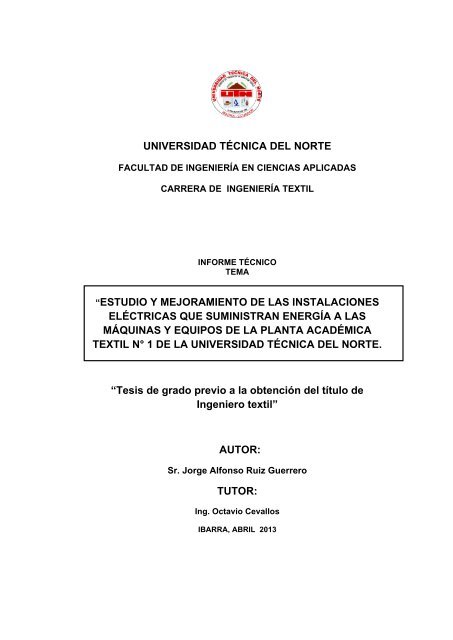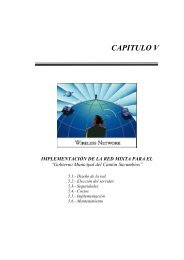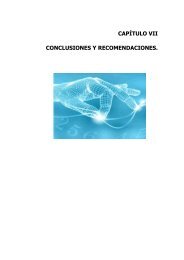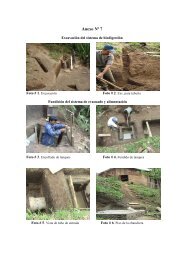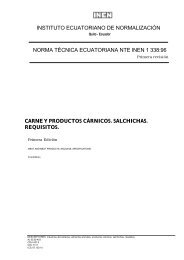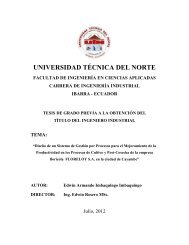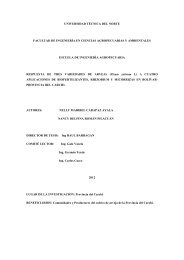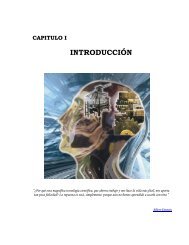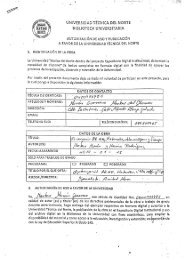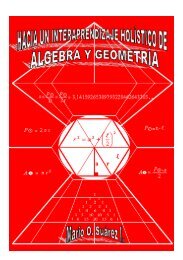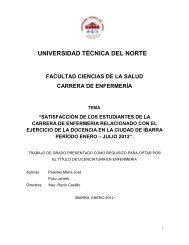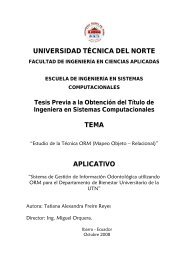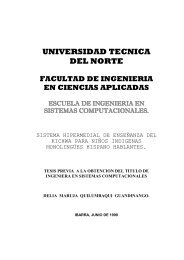INFORME TECNICO.pdf - Repositorio UTN
INFORME TECNICO.pdf - Repositorio UTN
INFORME TECNICO.pdf - Repositorio UTN
You also want an ePaper? Increase the reach of your titles
YUMPU automatically turns print PDFs into web optimized ePapers that Google loves.
UNIVERSIDAD TÉCNICA DEL NORTE<br />
FACULTAD DE INGENIERÍA EN CIENCIAS APLICADAS<br />
CARRERA DE INGENIERÍA TEXTIL<br />
<strong>INFORME</strong> TÉCNICO<br />
TEMA<br />
“ESTUDIO Y MEJORAMIENTO DE LAS INSTALACIONES<br />
ELÉCTRICAS QUE SUMINISTRAN ENERGÍA A LAS<br />
MÁQUINAS Y EQUIPOS DE LA PLANTA ACADÉMICA<br />
TEXTIL N° 1 DE LA UNIVERSIDAD TÉCNICA DEL NORTE.<br />
“Tesis de grado previo a la obtención del título de<br />
Ingeniero textil”<br />
AUTOR:<br />
Sr. Jorge Alfonso Ruiz Guerrero<br />
TUTOR:<br />
Ing. Octavio Cevallos<br />
IBARRA, ABRIL 2013
1. ENERGÍA ELÉCTRICA<br />
Generalidades<br />
Se denomina energía eléctrica a la<br />
forma de energía resultante de la<br />
interacción entre una diferencia de<br />
potencial entre dos puntos, y la<br />
corriente eléctrica.<br />
<br />
<br />
<br />
<br />
<br />
<br />
Energía Solar térmica por<br />
concentración<br />
Energía solar fotovoltaica<br />
Energía Eólica<br />
Energía Geotérmica<br />
Energía Mareomotriz<br />
Energía utilizando la<br />
Biomasa<br />
Historia de la energía.<br />
Las primeras aproximaciones<br />
científicas al fenómeno fueron<br />
hechas en los siglos XVII y XVIII por<br />
investigadores sistemáticos como<br />
Gilbert, Von Guericke, Henry<br />
Cavendish, Du Fay, van<br />
Musschenbroek y Watson.<br />
Generación de la energía<br />
eléctrica.<br />
La generación eléctrica se realiza,<br />
básicamente, mediante un<br />
generador; si bien estos no difieren<br />
entre sí en cuanto a su principio de<br />
funcionamiento, varían en función a<br />
la forma en que se accionan.<br />
Generación Termoeléctrica<br />
Se fundamenta en la utilización del<br />
calor para la generación de corriente<br />
eléctrica la cual se puede diferenciar<br />
en tres grandes grupos:<br />
a) Turbinas a Vapor<br />
b) Turbinas a Gas.<br />
c) Ciclos Combinados.<br />
Generación Hidroeléctrica<br />
Estas centrales utilizan como fuente<br />
de energía primaria un recurso<br />
renovable como lo es la fuerza de<br />
las aguas.<br />
Generación por formas no<br />
convencionales o renovables.<br />
Se enumeran en este punto a las<br />
fuentes energéticas que se utilizan<br />
actualmente en forma comercial,<br />
aunque lamentablemente todavía su<br />
participación porcentual en la<br />
ecuación energética mundial no es<br />
muy significativa.<br />
Situación de la generación<br />
eléctrica en el Ecuador<br />
El número total de centrales de<br />
generación es de 223 de las cuales<br />
94 están incorporadas al Sistema<br />
Nacional Interconectado -S.N.I.- y<br />
129 se encuentran aisladas y en su<br />
mayoría pertenece a empresas<br />
autogeneradoras.<br />
Transmisión de la energía<br />
eléctrica.<br />
Los generadores de las plantas<br />
hidroeléctricas y termoeléctricas<br />
pueden producir electricidad a unos<br />
13 mil voltios. Ese voltaje inicial es<br />
elevado, a través de<br />
transformadores en las propias<br />
instalaciones de la planta, hasta<br />
unos 230 mil voltios. Es así como<br />
viaja por cables de alta tensión y<br />
torres que los sostienen, a lo largo<br />
de cientos de kilómetros, hasta los<br />
lugares donde será consumida.<br />
Situación de la transmisión de<br />
energía en el Ecuador<br />
La transmisión a nivel nacional<br />
involucra toda la energía que fluye<br />
por dichas líneas, las cuales se han<br />
dividido en líneas de transmisión,<br />
cuyos voltajes de operación son<br />
superiores a los 69 kV (138 y 230kV)<br />
y las líneas de subtransmisión que<br />
operan con voltajes entre los 13,8 y<br />
69 kV.<br />
Distribución de energía eléctrica<br />
La energía eléctrica transportada<br />
antes de llegar a nuestros hogares,<br />
oficinas, fábricas, talleres y<br />
comercios, el voltaje es reducido en
subestaciones y mediante<br />
transformadores cercanos a los<br />
lugares de consumo. En las<br />
ciudades, el cableado eléctrico<br />
puede ser aéreo o subterráneo.<br />
Situación de la distribución de le<br />
energía eléctrica en el Ecuador.<br />
En uso del artículo 39 del capítulo<br />
VII de la Ley del Régimen del Sector<br />
Eléctrico, el CONELEC ha realizado<br />
la concesión de servicios de<br />
distribución de energía eléctrica a 11<br />
empresas eléctricas del país, las<br />
mismas que están obligadas a<br />
prestar estos servicios durante el<br />
plazo establecido en los contratos<br />
de concesión.<br />
2. SISTEMAS ELÉCTRICOS<br />
Conductores<br />
Un conductor eléctrico es aquel<br />
elemento que puesto en contacto<br />
con un cuerpo cargado de<br />
electricidad transmite ésta a todos<br />
los puntos de su superficie.<br />
Tipos de conductores.<br />
Se distinguen dos grandes grupos<br />
de aluminio y cobre los mismos que<br />
encontramos en aislados y<br />
desnudos.<br />
Aplicaciones de los conductores<br />
eléctricos.<br />
Las principales aplicaciones de un<br />
conductor eléctrico son el transporte<br />
de energía eléctrica.<br />
Circuitos eléctricos<br />
Es una interconexión de elementos<br />
eléctricos como resistencias,<br />
inductores, capacitores, líneas de<br />
transmisión, fuentes de voltaje,<br />
fuentes de corriente e interruptores.<br />
pero hay tres que deben usarse en<br />
todo tipo de instalación:<br />
Protección contra<br />
cortocircuitos<br />
Protección contra<br />
sobrecargas<br />
Protección contra<br />
electrocución.<br />
Normas para las instalaciones<br />
eléctricas.<br />
Para que las instalaciones eléctricas<br />
sean seguras y confiables se<br />
requiere:<br />
Planos de planta y alzado<br />
Diagrama unifilar<br />
Cuadro de distribución de<br />
cargas por circuitos<br />
Croquis de la ubicación<br />
Especificación de los<br />
materiales y equipos<br />
Memoria técnica descriptiva<br />
y de cálculo de acuerdo a las<br />
normas establecidas<br />
3. APARATOS DE MEDICIÓN<br />
Potencial y diferencia de potencial<br />
(V)<br />
La diferencia de potencial se define<br />
como el trabajo por unidad de carga<br />
ejercido por el campo eléctrico,<br />
sobre una partícula cargada, para<br />
moverla de un lugar a otro. Se<br />
puede medir con un voltímetro.<br />
Resistividad (Ω)<br />
Se le llama resistividad al grado de<br />
dificultad que encuentran los<br />
electrones en sus desplazamientos.<br />
Potencia eléctrica (P)<br />
Potencia es la velocidad a la que se<br />
consume la energía, se mide en<br />
joule por segundo (J/seg).<br />
Dispositivos de protección<br />
Existen muchos tipos de<br />
protecciones que pueden hacer una<br />
instalación eléctrica completamente<br />
segura ante cualquier contingencia,
4. MAQUINARIA TEXTIL<br />
Bobinadora-enconadora<br />
(SHWEITER)<br />
Se la utiliza para la formación de<br />
carretes o bobinas cónicas, a partir<br />
de madejas o de usos de la continua<br />
de hilar.<br />
La centrifuga<br />
La máquina de exprimir cuyo empleo<br />
es muy corriente es la centrifuga,<br />
consiste en un cesto cilíndrico<br />
vertical, cuyas paredes llevan unos<br />
orificios.<br />
Máquina lijadora.<br />
La finalidad de la máquina es<br />
producir el efecto de afelpado en la<br />
superficie del género textil, pudiendo<br />
trabajarse en estas telas de algodón,<br />
lana, acrílico, y sus mezclas.<br />
Máquina circular.<br />
Destinada a la producción de tela<br />
que se denomina tejido de Punto, a<br />
aquel en el cual los hilos se<br />
entrelazan mediante ondas más o<br />
menos sinuadas que le dan una<br />
elasticidad característica.<br />
Tejedora rectilínea.<br />
Destinada a producir prendas<br />
exteriores como sacos, bufandas,<br />
chompas, etc.<br />
Máquina de medias.<br />
Es una máquina manofactura<br />
provista de 86 agujas #6; con<br />
bastidor alimentador de 11 hilos, los<br />
mimos que pueden ser poliéster,<br />
algodón y sus mezclas.<br />
Máquinas de la confección<br />
Cortadora vertical.-<br />
Dispone de una cuchilla de<br />
acero que realiza el corte.
Overlock.- Pueden ser de 3<br />
o Hasta 5 hilos.<br />
<br />
<br />
Recta.- Realiza una costura<br />
lineal.<br />
Recubridora.- Empleada<br />
principalmente para para<br />
realizar dobleces.<br />
5. PARTE PRÁCTICA.<br />
Antecedentes<br />
La universidad Técnica del Norte a<br />
raíz de la creación de la carrera de<br />
Ingeniería textil, crea la Planta<br />
Académica textil N° 1 en 1987,<br />
ubicado en el sector de El Camal,<br />
entre las calles Luis Ulpiano de la<br />
Torre y Obispo de Jesús Yerovi, hoy<br />
en la parte posterior del Colegio<br />
Universitario, con un espacio físico<br />
total de 264 metros cuadrados de<br />
construcción mixta hierro-hormigón.<br />
Diagnóstico.<br />
Realizar un diagnóstico situacional<br />
del circuito eléctrico actual de la<br />
planta académica textil Nº 1 de la<br />
Universidad Técnica del Norte, con<br />
el fin de caracterizar el área de<br />
investigación.<br />
Fuentes de información.<br />
Para esta investigación se utilizaron<br />
textos, documentos, catálogos,<br />
folletos e internet que permitan<br />
investigar material informativo sobre<br />
el tema.<br />
Compresor<br />
Este equipo es parte fundamental<br />
dentro de una industria textil ya que<br />
el aire comprimido es utilizado por<br />
la mayoría de estas máquinas.<br />
Población y muestra.<br />
La población que se tomó en cuenta<br />
para la realización de la<br />
investigación es a los tres<br />
profesionales encargados de la<br />
Planta Académica Textil Nº 1 de la<br />
Universidad Técnica del Norte, y a<br />
69 estudiantes de la Escuela de<br />
Ingeniería Textil.
Levantamiento de la información<br />
técnica del estado del sistema<br />
eléctrico de la planta académica<br />
textil n° 1 de la Universidad<br />
Técnica del Norte.<br />
Es así que se determina que la<br />
instalación eléctrica actual es<br />
deficiente y no ofrece ninguna<br />
garantía de protección tanto a los<br />
equipos y máquinas como al<br />
personal que labora en esta planta<br />
académica.<br />
6. “ESTUDIO, CÁLCULO,<br />
DISEÑO E INSTALACIÓN DEL<br />
NUEVO SISTEMA ELÉCTRICO<br />
DE LA PAT 1 DE LA <strong>UTN</strong> –FICA<br />
CARRERA DE INGENIERIA<br />
TEXTIL Y MODAS”<br />
Antecedentes.<br />
La Facultad de Ciencias Aplicadas-<br />
FICA en su plan de difundir los<br />
conocimientos a los estudiantes de<br />
la carrera de Ingeniería Textil<br />
necesita de carácter urgente renovar<br />
las instalaciones eléctricas de la<br />
planta académica de Ingeniería<br />
Textil y Modas.<br />
Levantamiento de planos<br />
Es indispensable para realizar el<br />
estudio el levantamiento de planos<br />
de la ubicación de la maquinaria,<br />
con la finalidad de contar con<br />
información para el diseño eléctrico.<br />
Cálculos<br />
Para el dimensionamiento de<br />
conductores se realizó mediciones<br />
con la pinza amperimétrica cuando<br />
cada una de las maquinas estaban<br />
a plena carga, para garantizar que el<br />
conductor dimensionado para cada<br />
circuito sea el correcto.<br />
Instalación del nuevo sistema<br />
normativa y principios a seguir en<br />
el diseño.<br />
Para diseñar la instalación de los<br />
circuitos en baja tensión se utilizará<br />
la norma NEC americana, pues es el<br />
estándar de los constructores y<br />
distribuidores nacionales, asimismo<br />
incorporaremos, para efectos<br />
estéticos, tableros y canaletas<br />
plásticas decorativas construidas<br />
con norma europea.<br />
Desarrollo<br />
El sistema eléctrico, esta estudiado<br />
y diseñado para optimizar al máximo<br />
los recursos eléctricos y económicos<br />
7. ANÁLISIS DE COSTOS<br />
En el presente capítulo se determina<br />
todos los materiales y aditamentos<br />
que se requieren para la instalación<br />
del nuevo sistema, así como<br />
también se detalla el material<br />
eléctrico necesario.<br />
8. CONCLUSIONES Y<br />
RECOMENDACIONES<br />
Conclusiones:<br />
Las instalaciones eléctricas de la<br />
Planta Académica Textil Nº 1 de la<br />
Universidad Técnica del Norte no<br />
contaban con las condiciones<br />
técnicas de funcionamiento y de<br />
seguridad para los estudiantes y el<br />
personal de mantenimiento.<br />
Las instalaciones eléctricas han<br />
sido realizadas desde la<br />
construcción de la Planta Académica<br />
Textil N° 1, en el año de 1987 por lo<br />
que su mal estado se debe a su<br />
obsolescencia.<br />
El mal funcionamiento de las<br />
instalaciones eléctricas ha causado<br />
daño a los equipos y a 5<br />
maquinarias de la Planta Académica<br />
Textil Nº 1 de la Universidad técnica<br />
del Norte por lo que actualmente<br />
algunas de ellas se encuentran en<br />
mal estado y otras no funcionan<br />
definitivamente.
El nuevo sistema eléctrico instalado<br />
en la Planta Académica Textil Nº 1<br />
de <strong>UTN</strong>, se realizó con bases<br />
científicas y técnicas que permitieron<br />
recuperar la maquinaria, a través de<br />
un correcto diseño de los planos, un<br />
presupuesto del costo de instalación<br />
y optimizado; por lo que tiene<br />
actualmente un adecuado<br />
funcionamiento.<br />
Recomendaciones:<br />
Es necesario seguir un manual de<br />
procedimientos para operar el<br />
sistema eléctrico en la Planta<br />
académica Textil N° 1.<br />
Los responsables de la PAT 1 cada<br />
6 meses, deben hacer una revisión y<br />
mantenimiento completo de las<br />
instalaciones eléctricas para que se<br />
mantengan operativas.<br />
Los responsables de la PAT 1,<br />
deben recibir capacitación sobre<br />
mantenimiento de instalaciones<br />
eléctricas.<br />
La PAT 1 debe ser equipada con<br />
nueva maquinaria que vaya acorde<br />
con el avance tecnológico dentro de<br />
la industria textil, de esta manera se<br />
aprovecharía al máximo el nuevo<br />
sistema eléctrico instalado.<br />
Se debe promover un nuevo tema<br />
de investigación en la PAT 2, con la<br />
finalidad de dotar a esta de un<br />
nuevo sistema eléctrico.<br />
Debe buscarse el mecanismo<br />
adecuado con la finalidad de poner<br />
en producción a la maquinaria que<br />
posee la Planta textil ya que se tiene<br />
un potencial que no ha sido<br />
aprovechado de la mejor manera. Lo<br />
cual puede ser tema de una nueva<br />
investigación.<br />
BIBLIOGRAFÍA<br />
ALAMOS Juan Alercio, (2007)<br />
Sistema de Distribución de Energía<br />
Eléctrica, Guayaquil Editorial<br />
Universitaria ESPOL<br />
BAHRMAN, M.; Johnson, B. (2007)<br />
The ABCs of HVDC Transmission<br />
Technologies, revista IEEE Power &<br />
Energy, n.º 3/4, pp. 32–44.<br />
Bazán Gerardo, 2003<br />
http://www.eumed.net/tesis/2009/rjg/<br />
Transmision%20o%20transporte%2<br />
0de%20electricidad.htm<br />
CLOTWORTHY Allan, Proceedings<br />
World Geothermal Congress 2000.<br />
(consultado el 30 de marzo de 2006<br />
CRUX Guillermo, especial para PI.<br />
Fuente: International Socialism N°<br />
95, 2002.<br />
http://www.infoamerica.org/teoria_art<br />
iculos/zizek02.htm<br />
GIORDANO, José Luis (2006). «El<br />
conductor eléctrico, Profísica,<br />
Chile.». Consultado el 13 de<br />
mayo de 2008<br />
GRACÍA MUÑOZ Carlos (2006)<br />
http://www.profesorenlinea.cl/fisica/T<br />
ecnologia/CIRCUITOS_ELECTRICO<br />
S.htm<br />
GRACÍA MUÑOZ Carlos Física<br />
general, escrito por Santiago<br />
Burbano de Ercilla,<br />
HERNÁNDEZ ADROVER, Juan<br />
http://cienciaes.com/entrevistas/201<br />
2/05/24/energia-de-la-biomasahablamos-con-juan-j-hernandezadrover/<br />
HINOJOSA Danny Ayala:<br />
http://www.cambiemosecuador.co<br />
m/2005/10/ecuador_una_his.html<br />
JÁTIVA SEVILLA Vladimir:<br />
José Antonio E. García Álvarez<br />
http://www.asifunciona.com/electrote<br />
cnia/ke_voltaje/ke_voltaje_1.htm<br />
LANZILLOTTA Analía (2010)<br />
MILANES C. (2008) Circuitos<br />
eléctricos. Editorial Caracas<br />
Venezuela<br />
MONDE A Toutle<br />
http://www.oni.escuelas.edu.ar/olimp<br />
i98/energia-vsambiente/generaci.htm<br />
Recuperado<br />
12 febrero 2012
MORENO Julio José, (2008) Estudio<br />
de la energía Eléctrica) UASD<br />
MORENO S. (2008) ”.<br />
www.arqhys.com/arquitectura/lospolimeros.html<br />
Oudalov, A.; Reza, M., (2007).<br />
ExternalityImplicationonBulkEnergyT<br />
ransport, Actas de la XXVII<br />
Conferencia de la Asociación de<br />
EE.UU. para la Economía de la<br />
Energía), Houston, TX, EE.UU.<br />
PEDROCHE Ana<br />
Belénhttp://www.economiadelaenerg<br />
ia.com/2011/10/generacion-deenergia-electrica-a-partir-deresiduos/<br />
PROCOBRE: Revista México (2006)<br />
Revista “Producción” 2007 de<br />
Venezuela, Artículo Generación de<br />
Energía.<br />
ROSALES L. (2008) Energía<br />
Eléctrica, Editorial McGrawHill<br />
México<br />
SEARS Y ZEMANSKY (2009)<br />
Física Universitaria con Física<br />
Moderna Volumen 2, página 851.,<br />
decimosegunda edición.<br />
SEARS Y ZEMANSKY (2009)<br />
http://es.scribd.com/doc/61288382/F<br />
IS-02<br />
www.sapiensman.com/tematica/tem<br />
atica8.htm<br />
NADO.<strong>pdf</strong> Las partes constitutivas<br />
de esta maquinas<br />
www.alegsa.com.ar/Dic/circuito%20<br />
electrico.php<br />
http://www.profesorenlinea.cl/fisica/T<br />
ecnologia/CIRCUITOS_ELECTRICO<br />
S.htm<br />
http://repositorio.utn.edu.ec/bitstrea<br />
m/123456789/735/12/04%20IT%200<br />
94%20CAPITULO%20VIII%20BOBI<br />
NADO.<strong>pdf</strong> Las partes constitutivas<br />
de esta maquinas<br />
LINCONGRAFIA<br />
http://wwwDirectiva 2006/42/CE del<br />
Parlamento Europeo y del Consejo<br />
de 17 de mayo de 2006 relativa a las<br />
máquinas y por la que se modifica la<br />
Directiva 95/16/CE (refundición),<br />
DOUEL 157 de 9.6.2006, p. 24/86<br />
GARCÍA ÁLVAREZ José Antonio E.<br />
http://www.asifunciona.com/electrote<br />
cnia/ke_potencia/ke_potencia_elect_<br />
1.htm Recuperado el 21 de abril del<br />
2012<br />
GARCÍA Héctor A.<br />
http://www.proyectosalonhogar.com/<br />
tecnologia/el_maquinismo.htm<br />
Recuperado el 13 de mayo del 2012<br />
http://repositorio.utn.edu.ec/bitstrea<br />
m/123456789/735/12/04%20IT%200<br />
94%20CAPITULO%20VIII%20BOBI
1. ELECTRICITY<br />
Overview<br />
Electrical energy is called the way of<br />
energy as a result of the interaction<br />
between a potential difference<br />
between two points, and the electric<br />
current.<br />
History of energy.<br />
The first scientific approaches to the<br />
phenomenon were made in the<br />
seventeenth and eighteenth<br />
systematic researchers as Gilbert,<br />
Von Guericke, Henry Cavendish, Du<br />
Fay, van Musschenbroek and<br />
Watson.<br />
Generation of electrical energy.<br />
The power generation is carried out<br />
basically by a generator, although<br />
these do not differ in their operating<br />
principle, vary according to the way<br />
they are operated.<br />
Thermoelectric Generation<br />
It is based on the use of heat to<br />
generate electricity which can be<br />
differentiated into three main groups:<br />
a) Steam Turbines<br />
b) Gas Turbines.<br />
c) Combined Cycle.<br />
Hydroelectric Generation<br />
These special buildings use as a<br />
primary energy source as a<br />
renewable resource is the force of<br />
water.<br />
Generation by unconventional or<br />
renewable ways.<br />
We have in this group to the energy<br />
sources that are currently used<br />
commercially, but unfortunately still<br />
their percentage in the global<br />
energy equation is not very<br />
significant.<br />
• Solar thermal concentration<br />
• Solar photovoltaics<br />
• Wind Energy<br />
• Geothermal Energy<br />
• Tidal Energy<br />
• Biomass Energy using<br />
Power generation situation in<br />
Ecuador<br />
The total power generation is 223 of<br />
which 94 are incorporated into the<br />
national grid and 129-SNI-are<br />
isolated and largely self-generating<br />
companies belongs to.<br />
Electric power transmission.<br />
The generators of hydroelectric and<br />
thermoelectric plants can produce<br />
electricity for about 13,000 volts.<br />
This initial voltage is high, through<br />
transformers on site of the plant, up<br />
to about 230 thousand volts. It<br />
travels well as power lines and<br />
towers that support them, along<br />
hundreds of kilometers, to the places<br />
where it will be consumed.<br />
Status of the power transmission<br />
in Ecuador<br />
The national transmission involves<br />
all the energy that flows through<br />
these lines, which have been divided<br />
into transmission lines, which are<br />
higher operating voltages at 69 kV<br />
(138 and 230kV) and<br />
subtransmission lines operating at<br />
voltages between 13.8 and 69 kV.<br />
Distribution of electricity<br />
The energy transmission before<br />
reaching our homes, offices,<br />
factories, workshops and shops, the<br />
voltage is reduced by transformers<br />
and substations near points of<br />
consumption. In cities, the wiring can<br />
be overhead or underground.<br />
Status of the electrical power<br />
distribution in Ecuador.<br />
In use of Article 39 of Chapter VII of<br />
the Law on the Electricity Sector,<br />
CONELEC has made the granting of<br />
distribution services to 11 electric<br />
power utilities in the country, they
are required to provide these<br />
services during the applicable period<br />
in concession contracts.<br />
2. ELECTRICAL SYSTEMS<br />
Drivers<br />
An electrical conductor element that<br />
is in contact with a charged body<br />
transmits this power to all points of<br />
its surface.<br />
Kinds of conductors.<br />
There are two main groups of the<br />
same aluminum and copper found in<br />
isolated and naked.<br />
Applications of the electrical<br />
conductors.<br />
The main applications of electrical<br />
wire are the power transmissions.<br />
Circuits<br />
They are an interconnection of<br />
electrical elements such as resistors,<br />
inductors, capacitors, transmission<br />
lines, voltage sources, current<br />
sources and switches.<br />
Protective Devices<br />
There are many kinds of protections<br />
which can make an electrical<br />
installation completely safe in any<br />
case of contingence, but there are<br />
three that should be used in all kinds<br />
of installations:<br />
• Short-circuit protection<br />
• Overload<br />
• Electric shock protection.<br />
Standards for electrical<br />
installations.<br />
In order to get electrical installations<br />
being safe and reliable we require:<br />
• Floor plans and elevation<br />
• line diagram<br />
• Control circuit-load distribution<br />
• Sketch of the location<br />
• Specification of materials and<br />
equipment<br />
• Memory descriptive technique and<br />
calculation according to the rules set<br />
3. MEASUREMENT<br />
INSTRUMENTS<br />
Potential and potential difference<br />
(V)<br />
The potential difference is defined as<br />
the work per unit charge, the electric<br />
field exerted on a charged particle to<br />
move from one place to another. It<br />
can be measured with a voltmeter.<br />
Resistivity (Ω)<br />
Resistivity is called the degree of<br />
difficulty for electrons on the go.<br />
Electric power (P)<br />
Power is the rate which energy is<br />
consumed, measured in joules per<br />
second (J / sec).<br />
4. TEXTILE EQUIPMENT<br />
MACHINES<br />
Winder-coning (SHWEITER)<br />
It is used for the formation of conical<br />
bobbins or reels, skeins from or uses<br />
of the spinning frame.<br />
Sander.<br />
The purpose of the machine is to<br />
produce the effect of fleece on the<br />
surface of the textile fatory, these<br />
factories can be worked on cotton,<br />
wool, acrylic, and mixtures thereof.
woven through waves more or less<br />
sinuate that give a characteristic<br />
elasticity.<br />
Weaver rectilinear.<br />
Designed to produce outerwear such<br />
as jackets, scarves, sweaters, etc…<br />
Making machines<br />
Vertical cutter. - Has a steel<br />
blade cutting.<br />
Mean Machine.<br />
A machine fitted with 86 itself is<br />
manufactured needles # 6; feeder<br />
frame 11 with threads, which can be<br />
mimes polyester, cotton and<br />
mixtures thereof.<br />
• Overlock. - May be 3 or even 5<br />
strands.<br />
The centrifuge<br />
Squeezing machine whose use is<br />
very common is the centrifuge<br />
basket consists of a cylindrical<br />
vertical walls have holes.<br />
• Straight. - Performs a linear<br />
fashion.<br />
• wrapping. - Used mainly for to<br />
make folds.<br />
Circular machine.<br />
To produce clothing called knitting,<br />
to one in which the threads are
documents, catalogs, brochures and<br />
the Internet to enable research<br />
literature on the subject.<br />
Compressor<br />
This team is a fundamental part of a<br />
textile industry as the compressed<br />
air is used by most of these<br />
machines.<br />
5. PRACTICAL PART.<br />
Background<br />
Northern Technical University<br />
following the creation of the<br />
Engineering textile, make the textile<br />
career 1, in 1987, located in El<br />
Gamal, between streets Ulpiano Luis<br />
Obispo de la Torre and Yerovi<br />
Jesus, today on the back of the<br />
University, with a total floor space of<br />
264 square meters iron-concrete<br />
composite construction.<br />
Diagnosis.<br />
Conduct a situational analysis of<br />
electrical circuit current academic<br />
textile building 1, of the Technical<br />
University of the North, in order to<br />
characterize the research area.<br />
Sources.<br />
For this research we used texts,<br />
Population and sample.<br />
The population was taken into<br />
account in the conduct of research is<br />
the three professionals responsible<br />
for Academic Textile Plant No. 1<br />
North Technical University, and 69<br />
students from the School of Textile<br />
Engineering.<br />
Lift State Technical information<br />
Electrical system of faculty textile<br />
Number 1 Technical University<br />
North.<br />
Thus, it is determined that the<br />
electrical current is weak and offers<br />
no guarantee of protection for both<br />
equipment and machines like the<br />
people working in this faculty.<br />
6. "STUDY, CALCULATION,<br />
DESIGN AND INSTALLATION<br />
OF NEW ELECTRICAL SYSTEM<br />
1 TO PAT FICA <strong>UTN</strong>engineering<br />
career TEXTILE<br />
AND FASHION"<br />
Background.<br />
The Applied Sciences-FICA on its<br />
plan to disseminate knowledge to<br />
students of the Engineering Textile<br />
urgent need to renew the electrical<br />
installations of the faculty of Textile<br />
Engineering and Fashion.<br />
Surveying<br />
It is essential for the study surveying<br />
the location of the machinery, in<br />
order to have information for the<br />
electrical design.<br />
Calculations<br />
For wire sizing was performed using<br />
the current clamp measurements<br />
when each of the machines were<br />
fully loaded, to ensure that the driver<br />
for each circuit sizing is correct.
Installing the new rules and<br />
principles to be followed in the<br />
design.<br />
To design the installation of low<br />
voltage circuits used in the U.S.<br />
NEC, it is the standard national<br />
builders and distributors also<br />
incorporate, for aesthetic effects,<br />
panels and decorative plastic gutters<br />
built with European standard.<br />
Development<br />
The electrical system is studied and<br />
designed to fully optimize power and<br />
economic resources<br />
7. COST ANALYSIS<br />
This chapter determines all<br />
materials and supplies required for<br />
the installation of the new system, as<br />
well as detailing the necessary<br />
electrical equipment.<br />
8.CONCLUSIONS AND<br />
RECOMMENDATIONS<br />
Conclusions:<br />
Electrical installations Academic<br />
Textile Plant No. 1 North Technical<br />
University lacked the technical<br />
conditions of operation and safety for<br />
students and personnel.<br />
Electrical installations have been<br />
made since the construction of<br />
Academic Textile Plant No. 1 in the<br />
year of 1987 so their poor condition<br />
due to their obsolescence.<br />
The malfunctioning of electrical<br />
installations has caused damage to<br />
the equipment and 5 Academic<br />
machinery Textile Plant No. 1 North<br />
Technical University so now some of<br />
them are bad and some do not work<br />
permanently.<br />
The new electrical system installed<br />
in the plant Academic Textile No.1<br />
<strong>UTN</strong>, was scientifically based<br />
techniques that allowed recover the<br />
machinery, through proper design<br />
plans, an estimate of the cost of<br />
installation and optimized, so<br />
currently have proper operation.<br />
Recommendations:<br />
You need to follow a manual of<br />
procedures for operating the electric<br />
system in academic Textile Plant No.<br />
1.<br />
Those responsible for the PAT 1<br />
every 6 months, they must complete<br />
a review and maintenance of<br />
electrical installations to remain<br />
operational.<br />
Those responsible for the PAT 1<br />
should be trained in maintenance of<br />
electrical installations.<br />
The PAT 1 must be equipped with<br />
new machinery to be consistent with<br />
the technological advances in the<br />
textile industry, so it would make the<br />
most the new electrical system<br />
installed.<br />
It should promote a new research<br />
topic in the PAT 2 with the aim to<br />
provide this for a new electrical<br />
system.<br />
Appropriate mechanism should be<br />
sought in order to put into production<br />
machinery that has the textile plant<br />
because it has a potential that has<br />
not been exploited in the best way.<br />
This may be the subject of a new<br />
investigation.
BIBLIOGRAPHY<br />
ALAMOS Juan Alercio, (2007)<br />
Sistema de Distribución de Energía<br />
Eléctrica, Guayaquil Editorial<br />
Universitaria ESPOL<br />
BAHRMAN, M.; Johnson, B. (2007)<br />
The ABCs of HVDC Transmission<br />
Technologies, revista IEEE Power &<br />
Energy, n.º 3/4, pp. 32–44.<br />
Bazán Gerardo, 2003<br />
http://www.eumed.net/tesis/2009/rjg/<br />
Transmision%20o%20transporte%2<br />
0de%20electricidad.htm<br />
CLOTWORTHY Allan, Proceedings<br />
World Geothermal Congress 2000.<br />
(consultado el 30 de marzo de 2006<br />
CRUX Guillermo, especial para PI.<br />
Fuente: International Socialism N°<br />
95, 2002.<br />
http://www.infoamerica.org/teoria_art<br />
iculos/zizek02.htm<br />
GIORDANO, José Luis (2006). «El<br />
conductor eléctrico, Profísica,<br />
Chile.». Consultado el 13 de<br />
mayo de 2008<br />
GRACÍA MUÑOZ Carlos (2006)<br />
http://www.profesorenlinea.cl/fisica/T<br />
ecnologia/CIRCUITOS_ELECTRICO<br />
S.htm<br />
GRACÍA MUÑOZ Carlos Física<br />
general, escrito por Santiago<br />
Burbano de Ercilla,<br />
HERNÁNDEZ ADROVER, Juan<br />
http://cienciaes.com/entrevistas/201<br />
2/05/24/energia-de-la-biomasahablamos-con-juan-j-hernandezadrover/<br />
HINOJOSA Danny Ayala:<br />
http://www.cambiemosecuador.co<br />
m/2005/10/ecuador_una_his.html<br />
JÁTIVA SEVILLA Vladimir:<br />
José Antonio E. García Álvarez<br />
http://www.asifunciona.com/electrote<br />
cnia/ke_voltaje/ke_voltaje_1.htm<br />
LANZILLOTTA Analía (2010)<br />
MILANES C. (2008) Circuitos<br />
eléctricos. Editorial Caracas<br />
Venezuela<br />
MONDE A Toutle<br />
http://www.oni.escuelas.edu.ar/olimp<br />
i98/energia-vsambiente/generaci.htm<br />
Recuperado<br />
12 febrero 2012<br />
MORENO Julio José, (2008) Estudio<br />
de la energía Eléctrica) UASD<br />
MORENO S. (2008) ”.<br />
www.arqhys.com/arquitectura/lospolimeros.html<br />
Oudalov, A.; Reza, M., (2007).<br />
ExternalityImplicationonBulkEnergyT<br />
ransport, Actas de la XXVII<br />
Conferencia de la Asociación de<br />
EE.UU. para la Economía de la<br />
Energía), Houston, TX, EE.UU.<br />
PEDROCHE Ana<br />
Belénhttp://www.economiadelaenerg<br />
ia.com/2011/10/generacion-deenergia-electrica-a-partir-deresiduos/<br />
PROCOBRE: Revista México (2006)<br />
Revista “Producción” 2007 de<br />
Venezuela, Artículo Generación de<br />
Energía.<br />
ROSALES L. (2008) Energía<br />
Eléctrica, Editorial McGrawHill<br />
México<br />
SEARS Y ZEMANSKY (2009)<br />
Física Universitaria con Física<br />
Moderna Volumen 2, página 851.,<br />
decimosegunda edición.<br />
SEARS Y ZEMANSKY (2009)<br />
http://es.scribd.com/doc/61288382/F<br />
IS-02<br />
www.sapiensman.com/tematica/tem<br />
atica8.htm<br />
LINCOGRAPHY<br />
http://wwwDirectiva 2006/42/CE del<br />
Parlamento Europeo y del Consejo<br />
de 17 de mayo de 2006 relativa a las<br />
máquinas y por la que se modifica la<br />
Directiva 95/16/CE (refundición),<br />
DOUEL 157 de 9.6.2006, p. 24/86<br />
GARCÍA ÁLVAREZ José Antonio E.<br />
http://www.asifunciona.com/electrote<br />
cnia/ke_potencia/ke_potencia_elect_<br />
1.htm Recuperado el 21 de abril del<br />
2012
GARCÍA Héctor A.<br />
http://www.proyectosalonhogar.com/<br />
tecnologia/el_maquinismo.htm<br />
Recuperado el 13 de mayo del 2012<br />
http://repositorio.utn.edu.ec/bitstrea<br />
m/123456789/735/12/04%20IT%200<br />
94%20CAPITULO%20VIII%20BOBI<br />
NADO.<strong>pdf</strong> Las partes constitutivas<br />
de esta maquinas<br />
www.alegsa.com.ar/Dic/circuito%20<br />
electrico.php<br />
http://www.profesorenlinea.cl/fisica/T<br />
ecnologia/CIRCUITOS_ELECTRICO<br />
S.htm<br />
http://repositorio.utn.edu.ec/bitstrea<br />
m/123456789/735/12/04%20IT%200<br />
94%20CAPITULO%20VIII%20BOBI<br />
NADO.<strong>pdf</strong> Las partes constitutivas<br />
de esta maquinas


